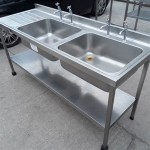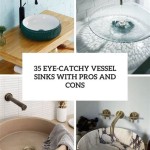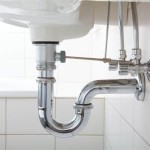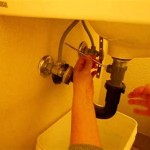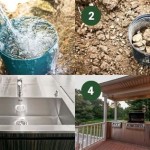Why Does My Bathroom Sink Keep Clogging?
A persistently clogged bathroom sink is a common household plumbing problem that can be frustrating and inconvenient. Identifying the root cause of the blockage is crucial for effective resolution and prevention of future occurrences. This article explores the most frequent culprits behind bathroom sink clogs, providing insights into the materials that commonly contribute to these issues and offering preventative measures to maintain a smoothly flowing drain.
Hair: A Primary Culprit
Hair is arguably the single most prevalent contributor to bathroom sink clogs. Strands of hair, whether from washing, shaving, or styling, inevitably find their way into the drain. The structure of hair, with its rough texture and tendency to intertwine, makes it particularly adept at catching on imperfections within the drainpipe. Over time, this accumulation of hair acts as a net, trapping other debris and gradually restricting the flow of water.
The problem is compounded by the presence of soap residue and other substances that adhere to the hair, creating a sticky mass that further exacerbates the blockage. Regularly cleaning the drain strainer, if present, helps to minimize the amount of hair entering the drainpipe. However, hair frequently bypasses the strainer or accumulates further down the drain where it is not easily accessible.
Preventative measures include using drain strainers with finer mesh and being diligent about removing visible hair from the sink and surrounding areas after grooming activities. Periodically flushing the drain with hot water can also help to dislodge some accumulated hair before it forms a significant blockage.
Soap Scum and Residue
Soap, while essential for hygiene, is also a significant contributor to sink clogs. Traditional bar soaps, in particular, contain fats and oils that react with minerals in the water to form a sticky, insoluble substance known as soap scum. This scum adheres to the walls of the drainpipe, gradually narrowing the passageway and impeding water flow.
Liquid soaps, while often perceived as less problematic, can also contribute to blockages. Many liquid soaps contain thickening agents and other additives that can solidify and accumulate within the drainpipe. Over time, this buildup can create a sticky residue that traps hair and other debris, leading to a persistent clog.
The type of water also plays a role. Hard water, with its high mineral content, exacerbates the formation of soap scum. Using water softeners can mitigate this problem, reducing the mineral content and minimizing the amount of scum that forms. Switching to soap alternatives, such as detergents designed to rinse cleanly, can also help to reduce the buildup of soap residue.
Regular flushing of the drain with hot water, ideally after each use, can help to dissolve some of the soap residue before it hardens and accumulates. Periodically pouring a mixture of baking soda and vinegar down the drain can also help to break down soap scum and other organic matter. The chemical reaction creates a fizzing action that helps to dislodge debris from the drainpipe walls.
Foreign Objects and Accidental Disposals
Small foreign objects inadvertently dropped or intentionally disposed of in the sink can also cause clogs. These objects can range from small toys and jewelry to toothpaste caps and bits of cotton swabs. These items often get lodged in the drainpipe, creating an immediate blockage or acting as a nucleus for the accumulation of other debris.
The S-trap, or P-trap, beneath the sink is specifically designed to trap these objects and prevent them from entering the main plumbing system. While this is beneficial in preventing widespread plumbing issues, it also means that the S-trap is a common location for clogs to form. Disconnecting and cleaning the S-trap is often the first step in resolving a sink clog caused by a foreign object.
Preventive measures include being mindful of the items placed near the sink and ensuring that small objects are securely stored away from the drain opening. Educating children about the importance of not flushing or disposing of toys or other items down the drain is also crucial. Using a drain strainer with a fine mesh can help to prevent larger objects from entering the drainpipe.
Buildup of Toiletries and Personal Care Products
Many toiletries and personal care products, such as toothpaste, shaving cream, and makeup, are not designed to be disposed of down the drain. These products often contain ingredients that can solidify or bind together, creating a thick, pasty substance that adheres to the drainpipe walls.
Toothpaste, in particular, can be a significant contributor to clogs. Many toothpaste brands contain thickeners and binders that can solidify in the drainpipe, especially when mixed with water and other debris. Shaving cream, while designed to dissolve in water, can also contribute to clogs, especially if used in large quantities.
Makeup products, such as foundation and concealer, often contain oils and waxes that can solidify and adhere to the drainpipe walls. These products can also attract hair and other debris, further exacerbating the blockage. Proper disposal of these products in the trash is essential for preventing sink clogs.
Rinsing the sink thoroughly after each use can help to minimize the buildup of toiletries. Using a drain strainer can also help to prevent larger particles of these products from entering the drainpipe. Consider using alternative methods for removing makeup, such as using makeup wipes or removing makeup over a trash can to prevent accidental disposal down the drain.
Pipe Corrosion and Mineral Deposits
Over time, the drainpipes themselves can contribute to clogs due to corrosion and mineral deposits. Older pipes, particularly those made of galvanized steel, are susceptible to corrosion, which can create rough surfaces that trap debris. This corrosion can also narrow the internal diameter of the pipe, restricting water flow.
Mineral deposits, particularly in areas with hard water, can also accumulate on the inside of the drainpipes. These deposits, primarily composed of calcium and magnesium, can gradually narrow the passageway and create a breeding ground for bacteria and other microorganisms. The buildup of these deposits can significantly reduce the efficiency of the drain and increase the likelihood of clogs.
Regular maintenance, such as flushing the drain with a descaling solution, can help to remove mineral deposits and prevent corrosion. Inspecting the pipes for signs of damage or corrosion is also important. If significant corrosion or mineral buildup is present, replacing the drainpipes may be necessary. Consider using PVC or copper pipes, which are less susceptible to corrosion and mineral deposits, for replacement.
Insufficient Water Flow
Sometimes, a clog is not caused by a specific material but rather by insufficient water flow. If the water pressure in the bathroom is low, it may not be sufficient to effectively flush debris down the drainpipe. This can lead to a gradual accumulation of hair, soap scum, and other materials, eventually resulting in a clog.
Low water pressure can be caused by a variety of factors, including a faulty water pressure regulator, corroded pipes, or a blockage in the main water line. Addressing the underlying cause of the low water pressure is essential for preventing future sink clogs.
Ensuring that the faucet is fully open when using the sink can also help to improve water flow. If the faucet aerator is clogged, cleaning or replacing it can also improve water pressure. Consider installing a low-flow faucet aerator that provides adequate water pressure while conserving water.
In some cases, increasing the diameter of the drainpipe can also improve water flow. A larger diameter pipe will allow more water to pass through, reducing the likelihood of debris accumulating and causing a clog.

Why Is My Sink Clogged Mike Diamond

Why Is Your Bathroom Sink Clogged Order A Plumber

5 Natural Ways To Unclog A Bathroom Sink Hiller How

How To Unclog A Bathroom Sink The Home
.png?strip=all)
What Keeps Clogging My Drain

Why Does My Bathroom Sink Clog

Why Do My Sinks Keep Clogging

How To Prevent Drain Clogs In Your Home Patrolplumbing

5 Surprising Items That Will Clog Your Bathroom Sink

Why Do My Drains Keep Clogging Carmel In Sink Toilet Pipes
